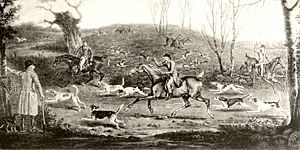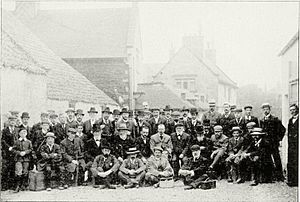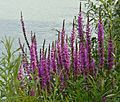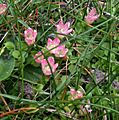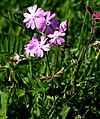Farnham Mires facts for kids
| Site of Special Scientific Interest | |
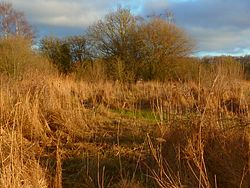
The mire
|
|
| Area of Search | North Yorkshire |
|---|---|
| Coordinates | 54°02′18″N 1°29′07″W / 54.0384°N 1.4853°W |
| Interest | Biological |
| Area | 10.3341 hectares (0.1033 km2; 0.03990 sq mi) |
| Notification | 1954 Revised 13 January 1984 |
| Location map | Magic Map (Defra) |
Farnham Mires is a special natural area in North Yorkshire, England. It's known as a Site of Special Scientific Interest (SSSI). This means it's a protected place because of its unique plants and wildlife.
The site has a wet, marshy area called a mire or fen, fed by natural springs. Here you can find plants like reeds and sedges. There are also drier parts with special calcareous grassland. This type of grassland grows on soil rich in lime and supports many different kinds of plants.
For a long time, people were interested in Farnham Mires for hunting. But later, scientists called botanists (plant experts) discovered its amazing variety of flowering plants. Because of these special plants, Farnham Mires became an SSSI in 1954. This site is not open to the public and does not have visitor facilities.
Contents
History of Farnham Mires
In the 1800s, Farnham Mires was a place where people hunted foxes. It was part of the area used by the York and Ainsty Hunt. Sometimes, people also illegally hunted animals there, which is called poaching. For example, in 1856, three men were sent to prison for poaching and fighting with those who tried to catch them.
However, by the late 1800s, people started to notice the incredible plants at Farnham Mires. The Yorkshire Naturalists' Union (YNU), a group of nature lovers, visited the site in 1885 and 1894. During their 1885 visit, a local vicar, Reverend Robert Elmhirst, showed them many rare plants found at the Mires.
In 1943-1944, more special plants were found here. These included water dropwort, water pimpernel, eyebright, blunt-flowered rush, fen pondweed, cotton grass, and black sedge. In 1944, there were plans to turn Farnham Mires into farmland. But thanks to efforts by conservation groups, these plans were stopped. This helped protect the unique plants and habitats of the Mires.
Where is Farnham Mires?
Farnham Mires is a Local Wildlife Site and a Site of Special Scientific Interest (SSSI). It covers about 10.3 hectares (about 25 acres). The site is located west of the village of Farnham, North Yorkshire, next to Low Moor Lane.
The area has a marsh fed by natural springs and drier calcareous grassland. This grassland grows on Magnesian Limestone. The southern part of the site still has many of its original plants. However, farming activities have changed some of the natural plants in the northern part.
Farnham Mires was first protected as an SSSI in 1954. Its status was reviewed and confirmed in 1984. This was because it still had its original grassland and marsh areas. These areas are important because they allow rare and local plant species to grow. Even though some parts have been affected by farming, the site is still very valuable. It is one of the few remaining marshlands in the Vale of York that are dominated by sedges and rushes.
Plants and Animals at Farnham Mires
Please note: Most of the pictures in this section are examples of the plants and animals mentioned. They were not necessarily taken at Farnham Mires itself.
Amazing Plants (Flora)
In 1943, plant experts George Taylor and E.C. Wallace visited Farnham Mires. They described the area as being "thickly carpeted" with cowslips and hairy violets. During the peak flowering season, they saw a "truly magnificent array" of fragrant orchids and spotted orchids.
Some of the other interesting plants they found in 1943 included:
- Salad burnet
- Parsley water dropwort
- Pepper saxifrage
- Guelder rose
- Hemp-agrimony
- Hoary ragwort
- Bird's-eye primrose
- Brookweed
- Butterwort
- Common centaury
- Common gromwell
- Rhinanthus stenophyllus (yellow rattle)
- Potamogeton densus (pondweed)
- Twayblade
- Green-winged orchid
- Early purple orchid
- Heath spotted orchid
- Bee orchid
- Autumn crocus (meadow saffron)
- Blunt-flowered rush
- Black bog-rush
- Various sedges like Blysmus compressus, Eriophorum latifolium, hairy sedge, distant sedge, Carex fulva, Carex lepidocarpa, glaucous sedge, carnation sedge, Carex caryophyllea, brown sedge, and flea sedge.
- Grasses such as heath false-brome and erect brome.
- Adder's tongue fern.
By 1984, the marshy areas mainly had common reed, Juncus inflexus (hard rush), and blunt-flowered rush. Other plants found there included great willowherb, purple loosestrife, and meadowsweet. In wetter spots, there was a "carpet" of bryophytes (mosses and liverworts), along with Carex lepidocarpa (long-stalk yellow sedge), carnation sedge, Valeriana dioica (marsh valerian), and marsh arrowgrass. These grew among more common plants like lesser hairy-willowherb, marsh pennywort, and marsh horsetail.
Around the marsh, there is grassland with neutral soil. Here you can find twayblade, common spotted orchid, common agrimony, pepper saxifrage, and knapweed, along with other herbs.
There's also a special area of calcareous grassland that isn't waterlogged. This area has many different plant species. You can find patches of buckthorn and hawthorn trees. This area is kept healthy by light grazing, which helps different grasses, sedges, and herbs grow.
Some of the grasses found here are purple moor-grass, heath grass, quaking grass, and hairy oat. The sedges include glaucous sedge. Many orchids thrive here, such as the bee orchid and fragrant orchid. Other herbs include adder’s-tongue fern, cowslip, hoary plantain, yellow rattle, and betony.
Natural England (a government body that protects nature) has highlighted several special wetland plants at Farnham Mires. These include Oenanthe lachenalii (parsley water dropwort), brookweed, and bog pimpernel. Important drier-land plants are felwort (autumn gentian) and bird’s-eye primrose.
-
Oenanthe lachenalii (parsley water dropwort)
Animals (Fauna)
Farnham Mires was not specifically protected for its animals. However, some animals have been noted there. In 2015, there was a mention of rabbits causing some issues.
In 1970, a huge flock of 60,000 starlings was seen in a hawthorn thicket at the site. Historical records also show that foxes have been found at Farnham Mires.
Other Living Things
When botanists Taylor and Wallace visited in 1943, they also noticed a "rich insect fauna," meaning many different kinds of insects. They felt that because of the many insects and plants, the area should be considered for a nature reserve.
How Farnham Mires is Maintained
To keep Farnham Mires healthy and full of diverse life, it needs careful maintenance.
Caring for the Mire
The marshy area is a special type of fen fed by springs. It needs to be maintained so that its unique plants and animals can continue to thrive. The minerals in the groundwater from the springs support plants like rushes, sedges, and mosses.
It's important that the underground water sources (called aquifers) are not harmed. This means avoiding too much water extraction for commercial use. Also, the water should not be polluted by too much farm fertiliser or industrial waste. A small amount of fertiliser can be used, but only downhill from the springs. Light grazing by animals helps keep the springs clear and the grasses short.
Caring for the Grassland
The calcareous grassland can support many different plants. But it needs to be maintained to stop it from being overgrown by tall grasses and scrub (small bushes). Light grazing in winter is recommended. This helps create plants of different heights, which in turn supports invertebrates (like insects) and other wildlife.
To protect the diverse plant life, pesticides are not used. Also, fertilisers are discouraged because the special plants here need the naturally poor soil conditions of the calcareous grassland to grow well.


